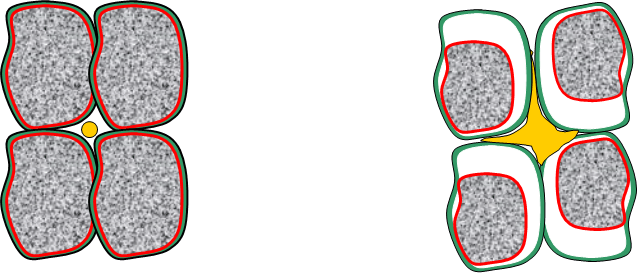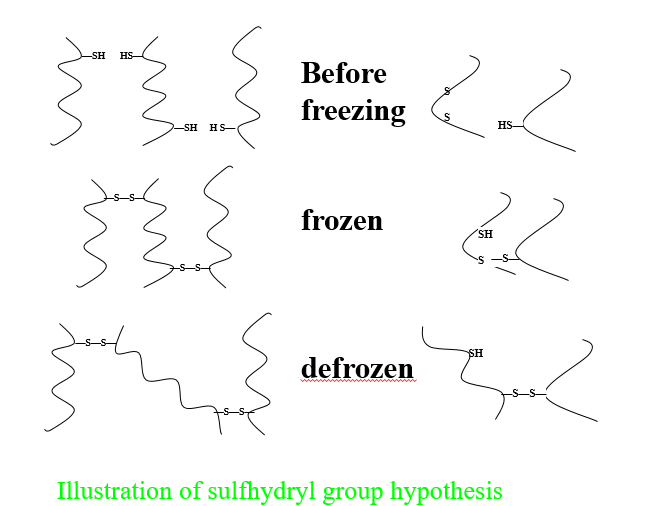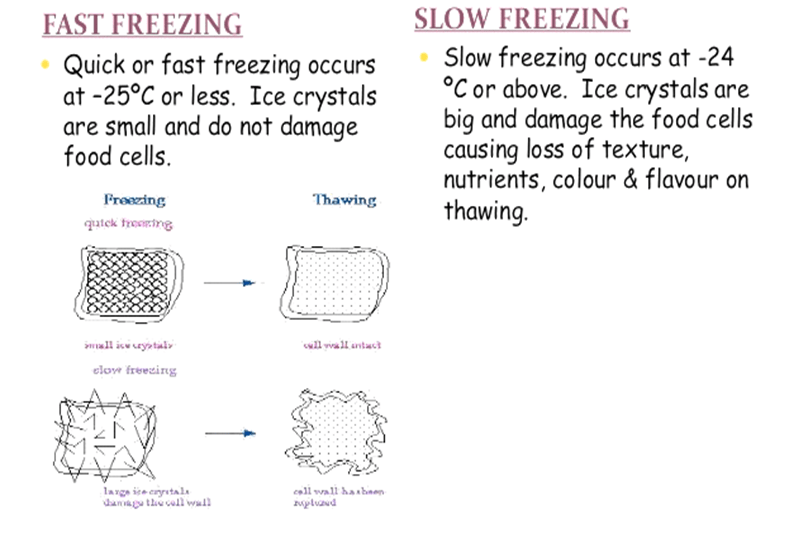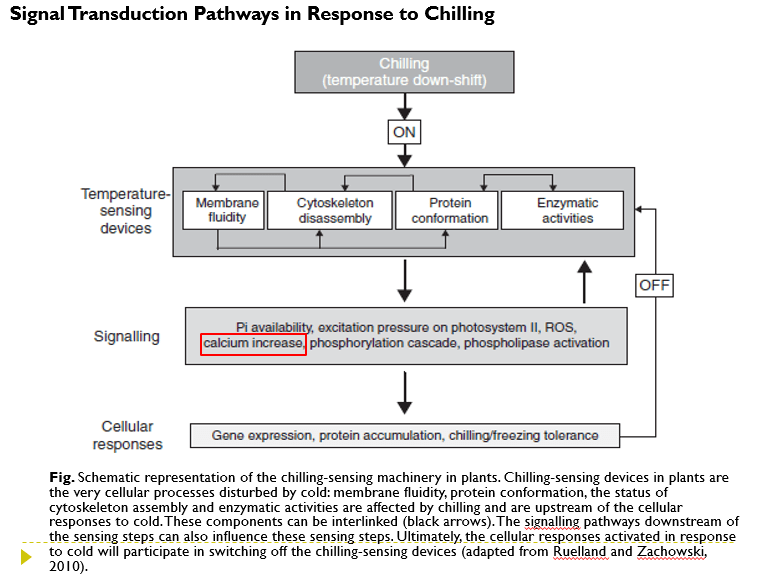Freezing Injury and Chilling Frost Tolerance in Plants
Freezing Injury and Chilling Frost Tolerance in Plants
Mechanism of freezing (frost )injury
Freezing:(intercellular and intracellular freezing)
(1) Intercellular freezing

Intercellular freezing occurs when temperature falls gradually.
2)Intracellular Freezing :
Intracellular freezing often occurs when temperature falls suddenly.
Ice results in the direct injury in
Cytoplasm
Bio-membrane
Organelle
damages to cell compartmentation and metabolic disorder.
Much more serious damage is caused by Intracellular Freezing than by Intercellular Freezing.
damage of protein:
Sulfhydryl group hypothesis(disulfide bridge hypothesis )\

Supported Exp:
(1) -S-S一increase and soluble -SH decrease after plant tissue faces to freezing.
}(2) Less-S-S-and more-SH of protein in the resistant-freeze plants.
(3) The plant with free-SH, glutathione, is more resistant to freeze.
(4) Artificial -SH, mercapthanol increases resistance of plant to low temperature.
Ice Crystal Formation and Protoplast Dehydration Kill Cells
The ability to tolerate freezing temperatures under natural conditions varies greatly among tissues.
Seeds, other partly dehydrated tissues, and fungal spores can be kept indefinitely at temperatures near absolute zero (–273°C), indicating that these very low temperatures are not intrinsically harmful.
- Fully hydrated, vegetative cells can also retain viability if they are cooled very quickly to avoid the formation of large, slow-growing ice crystals that would puncture and destroy subcellular structures.
- Ice crystals that form during very rapid freezing are too small to cause mechanical damage.
- Conversely, rapid warming of frozen tissue is required to prevent the growth of small ice crystals into crystals of a damaging size.
Types of Freezing

Among the factors that influence when a plant freezes are:
(i) moisture and extrinsic ice-nucleating agents;
(ii) hydrophobic barriers to ice propagation;
(iii) plant structure
(iv) ice nucleators, antifreeze proteins, sugar and antinucleators.
- Moisture and extrinsic ice-nucleating agents
Dry plants will supercool to a lower temperature than wet plants.
The presence of ice nucleating agents that are active at warm, sub-zero temperatures will influence the temperature at which a plant freezes but the nucleators must be in an aqueous solution.
- Hydrophobic barriers
Ice crystals must physically grow through a crack in the cuticle, a broken epidermal hair, or a stoma to induce ice nucleation within a plant .
Therefore, hydrophobic barriers, such as a thick, waxy cuticle or a synthetic substance applied to the plant surface, can prevent frost on the surface of a plant from initiating an internal ice nucleating event.

- Plant structure
While the factors that determine where ice forms and accumulates within a plant are not well understood it is clear that ice formation within a plant is not uniform but rather occurs in selected sites.
Where ice forms, how it propagates and how it is accommodated are all important factors that affect the ability of a plant to survive freezing and may be as important as the ability of a cell to tolerate the dehydrative stress associated with extracellular ice formation.
- Icenucleators
The compound responsible for ice nucleating activity in INA bacteria has been identified as a protein and the gene coding for the protein has been identified.
In contrast, compounds responsible for intrinsic ice nucleating activity observed in many woody plants have not been identified.
5. Antifreeze proteins, antinucleators and sugars
Several specialized plant proteins may help limit the growth of ice crystals by a noncolligative mechanism. These antifreeze proteins are induced by cold temperatures, and they bind to the surfaces of ice crystals to prevent or slow further crystal growth.
Cryoprotective Agents
- Sugars and some of the cold-induced proteins are suspected to have (cryo– = “cold”) effects; they stabilize proteins and membranes during dehydration induced by low temperature.
- Sucrose predominates among the soluble sugars associated with freezing tolerance that function in a colligative fashion, but in some specie raffinose, fructans, sorbitol, or mannitol serves the same function.
- During cold acclimation of winter cereals, soluble sugars accumulate in the cell walls, where they may help restrict the growth of ice. A cryoprotective glycoprotein has been isolated from leaves of cold-acclimated cabbage.
- Antinucleators (compounds that inhibit the activity of ice nucleators) have been reported from microorganisms, insects, plants.
- Synthetic Polymers, Extracellular fluids obtained from cold acclimated and non-acclimated plants contain sugars, proteins and unidentified substances, which can affect the rate of ice propagation

Some Bacteria That Live on Leaf Surfaces Increase Frost Damage
- When leaves are cooled to temperatures in the –3 to –5°C range, the formation of ice crystals on the surface (frost) is accelerated by certain bacteria that naturally inhabit the leaf surface
- Act as ice nucleators.
- Examples
- Pseudomonas syringae
- Erwinia herbicola
- Bacterial strains can be genetically modified so that they lose their ice-nucleating characteristics.
- Such strains have been used commercially in foliar sprays of valuable frost sensitive crops like strawberry to compete with native bacterial strains and thus minimize the number of potential ice nucleation points.
ABA and Protein Synthesis Are Involved in Acclimation to Freezing
- Many genes/Proteins induced by freezing are same as induced by ABA under non-acclimating conditions.
- homology with the RAB/LEA/DHN (responsive to ABA, late embryo abundant, and dehydrin.
- Plants hardened by water shortages; the freezing tolerance also increases.
Numerous Genes Are Induced during Cold Acclimation
Expression of certain genes and synthesis of specific proteins are common to both heat and cold stress, but some aspects of cold-inducible gene expression differ from that produced by heat stress.
Proteins Induced
- heat shock proteins that can act as molecular chaperones
- antifreeze proteins. Antifreeze proteins confer to aqueous solutions the property of thermal hysteresis (transition from liquid to solid is promoted at a lower temperature than is transition from solid to liquid), and thus they are sometimes referred to as thermal hysteresis proteins (THPs; i.e. lower the freezing point of water below the melting point).
- Several types of cold-induced, antifreeze proteins have been discovered in cold-acclimated winter-hardy monocots.
- When the specific genes coding for these proteins were cloned and sequenced, it was found that all antifreeze proteins belong to a class of proteins such as endochitinases and endoglucanases, which are induced upon infection of different pathogens. These proteins called pathogenesis related (PR) proteins are thought to protect plants against pathogens.
- It thus appears that at least in monocots, the dual role of these proteins as antifreeze and pathogenesis related proteins might protect plant cells against both cold stress and pathogen attack.
- proteins involved in the synthesis of osmolyte.
- proteins for membrane stabilization
- the LEA proteins.

Role of calcium in relation to cold stress
Calcium is an important messenger in a low temperature signal transduction pathway.
The change in cytosolic calcium levels is a necessary first step in a temperature sensing mechanism, which enables the plant to withstand future cold stress in a better way.
Cytoplasmic calcium levels increase rapidly in response to low temperature, largely due to an influx of calcium from extracellular stores.
Through the use of pharmacological and chemical reagents, it has been demonstrated that calcium is required for the full expression of some of the cold induced genes including the COR6 and KIN1 genes of Arabidopsis
For example, Ca2+ chelators and Ca2+ channel blockers such as La3+ inhibited the cold-induced calcium and resulted in the decreased expression of the cold Induced genes
Ca-mediated Signal Transduction Pathways in Response to Chilling

Fig. General scheme of chilling response in plants
Methods to increase Resistance to low temperature
- Select and use chilling tolerant species/cultivars
- Low temperature hardening
- Chemical control
- ABA, CCC, etc..)
- Proper planting dates
- Artificial covers
- Proper soil moisture

